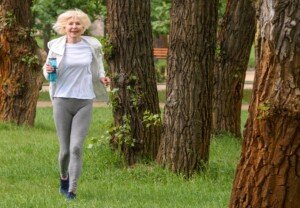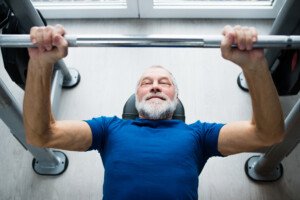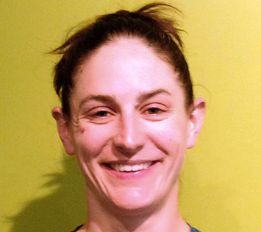![]()
Intense exercise is one of the best things an older person can do for his or her “aging” body.
“Taking it easy” and sitting around all day will cause far more harm to the aged body than will a good set of dumbbell exercises and other forms of intense training.
There is nothing about being old that inherently bars a person from intense exercise.
The problem is when a person has a long history of sedentary living (especially combined with smoking or obesity), such that by the time they’re of senior age — they have mobility and/or stamina impairments.
Cardio-based Intense Exercise
“High intensity interval training can be safe for older adults who are already in shape,” says Monica Charlton, a senior exercise specialist and certified Silver Sneakers/personal trainer out of New Orleans.

Depositphotos.com
“Those who are new to the practice will need to work up to high intensity training.
“As far as cardio goes, it is generally recommended that seniors perform moderate to vigorous cardio exercise for 20-30 minutes 3-5 days a week.”
High intensity interval training (HIIT) involves very brief, high efforts alternating with a few to several minutes of a recovery pace.
An example would be pedaling like a mad demon for 30 seconds on a stationary bike, then pedaling leisurely for three minutes.
Weight-bearing Intense Exercise
There term “intense” can mean different things. For some, it means lifting very heavy weight with long rests in between — causing one to be winded — but there’s no “muscle burn.”

Shuttersotck/Halfpoint
For others it means 10 to 15 challenging repetitions with only one minute in between, creating a fiery “muscle burn,” but the person isn’t breathing too hard, either.
An elderly person may be able to deadlift or bench press a lot of weight, yet struggle with walking inclines.
Others can sprint 100 yards in the hot sun yet struggle with barbell squats.
Find the type of workout that works best for you, but ideally you’ll want to do both aerobic and strength training routines — with some intensity tossed into both forms.
Elderly people should get a full physical to make sure that it’s okay to do any kind of high effort activity. Even if you’re healthy, you should start out gradually.
If you’re healthy, then age is truly JUST A NUMBER when it comes to intense workouts.
Start Out Slowly
Older people who are brand new to structured exercise will need to take things slowly and make sure they don’t have medical conditions (such as spinal stenosis) that can be worsened with certain forms of exercise.

Shutterstock/MilanMarkovic78
Older people who’ve been regularly exercising, however, can step it up a notch, or two.
Most don’t because they don’t believe older people should exercise intensely.
Or, they think they’re exercising intensely when they’re actually not; or, they don’t think intense exercise will benefit them. They are so wrong on that last point.
If you’re concerned about the safety of intense exercise, get a thorough exam with a cardiologist and orthopedic specialist — not just from your primary care physician.
Older people should not fear intense exercise.
Scientists at the Neuromuscular Research and Rehabilitation Laboratory at the University of Missouri stated in the Dec. 2010 Journal of Strength & Conditioning Research:
“High speed power training improved speed-related muscle performance characteristics compared to traditional slow-speed resistance training, particularly at lower external resistances. . . based on these findings, we recommend including a resistance training protocol in older adults that emphasizes high-speed movements at low external resistance.”
An older person should never back down from intense exercise just because a family member says, “You’re too old for that.”
 Monica Charlton’s personal training services include fitness/body composition assessments, nutrition planning, running programs and customized programs for clients with disabilities or injuries, as well as older and mainstream clients.
Monica Charlton’s personal training services include fitness/body composition assessments, nutrition planning, running programs and customized programs for clients with disabilities or injuries, as well as older and mainstream clients.
 Lorra Garrick is a former personal trainer certified through the American Council on Exercise. At Bally Total Fitness she trained women and men of all ages for fat loss, muscle building, fitness and improved health.
Lorra Garrick is a former personal trainer certified through the American Council on Exercise. At Bally Total Fitness she trained women and men of all ages for fat loss, muscle building, fitness and improved health.
.









































